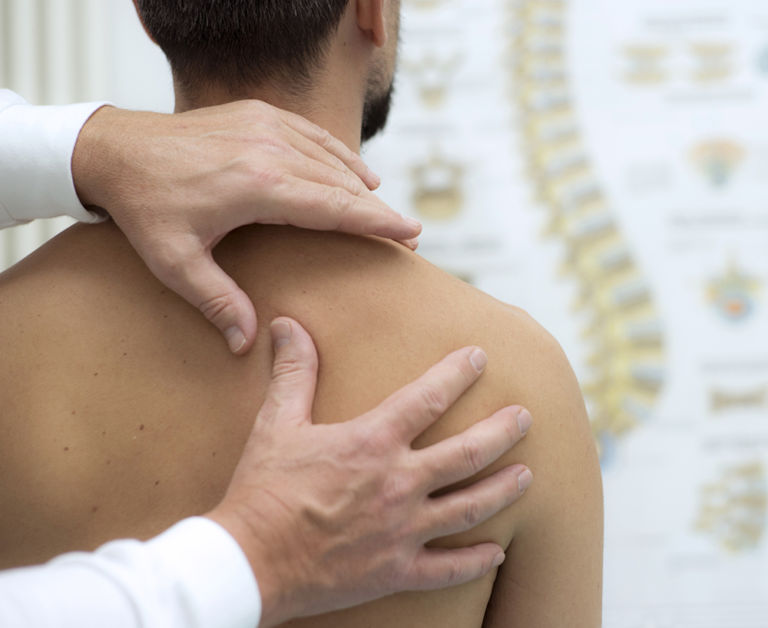Exploring the complexity of shoulder pain
As a seasoned physical therapist with nearly two decades of experience, I’ve encountered numerous cases of shoulder pain. Shoulder pain is one of the most common musculoskeletal issues people face, and it is not uncommon for a PT to see more than one shoulder patient on any given day. In this blog, I’ll delve into the intricacies of shoulder pain, drawing from my expertise to provide insights and guidance for those grappling with the challenges associated with it.
Dispelling myths: Debunking the connection between joint noises and injury
Patients often ask whether a loud popping sound in their shoulder indicates a serious injury. Most often, the answer is, “No.” Our joints pop and click and make various noises all the time. So, while there are times when a loud pop happens in a moment of some sort of trauma and can therefore correlate to an injury such as a tendon tearing or a ligament popping, most often the sounds our joints make are normal and harmless.
Shoulder pain typically has a gradual onset and arises from a culmination of factors rather than a single traumatic, noisy event.
The multifactorial nature of shoulder pain: Unpacking the underlying causes
Shoulder pain ranks among the most prevalent musculoskeletal complaints, alongside neck and low back pain.

The complexity of the shoulder joint, with its wide range of motion and intricate muscle interactions, makes it particularly susceptible to dysfunction. Understanding the unique biomechanics of the shoulder is essential for effective assessment and treatment of pain and dysfunction.
Additionally, we have what we think of as the shoulder joint (the glenohumeral joint), but then we also have our acromioclavicular joint (AC joint) and our sternoclavicular joint (SC joint) which help keep the shoulder stable and secure while stationary and while in motion.
Furthermore, the shoulder blade (scapula) is an important bone when it comes to shoulder function. Muscles play a part as well, including the four rotator cuff muscles and scapular muscles.
Weaknesses, stiffness, and biomechanical imbalances often contribute to shoulder discomfort. It is also important to note that shoulder issues are not isolated; they may be exacerbated by weaknesses or imbalances in adjacent areas such as the neck and upper back. Thorough assessments and targeted interventions in these regions are essential for comprehensive shoulder pain management. By addressing the root causes of dysfunction, we can facilitate lasting relief and improved function.
The rise of physical therapy as a diagnostic resource
In recent years, there has been a notable shift in patient behavior, with more individuals seeking physical therapy first, often taking advantage of direct access laws.
As the public becomes increasingly aware of the advanced education level a Doctor of Physical Therapy has, there is a growing trust in our expertise and our ability to provide accurate assessments utilizing the same physical exams orthopedic surgeons or primary care physicians use.
Many are rethinking the role of imaging in shoulder pain diagnosis. Contrary to historically popular belief, imaging, such as X-rays or MRIs, isn’t always necessary for an accurate diagnosis.

This trend, fueled in part by the educational content we share online, reflects a growing trust and personalized treatment plans created by physical therapists while working closely with patients, utilizing shared decision making.
While imaging tools can offer valuable insights in certain cases, conservative approaches such as physical therapy yield comparable assessments with fewer risks and lower costs. By leveraging our expertise, we can guide patients toward effective solutions for their shoulder pain, while minimizing unnecessary procedures.
A collaborative approach to personalized PT for shoulder pain
Effective treatment for shoulder pain often involves a multifaceted approach, including manual therapy, targeted exercises, and patient education. By collaborating with patients to set realistic goals and tailor interventions to their needs, physical therapists optimize outcomes and promote long-term recovery.

In addition to addressing existing shoulder issues, it’s essential to adopt proactive strategies for prevention. Proper warm-up and conditioning before engaging in activities that stress the shoulder, such as throwing or overhead sports, can reduce the risk of injury and enhance performance. By incorporating these practices into your routine, you can support optimal shoulder health and function.
Home exercise programs play a crucial role in reinforcing progress made during clinic sessions and empowering individuals to take control of their health and prevent future pain or injury.
Patient education is the heart of physical therapy. By providing individuals with a deeper understanding of their condition and treatment plan, we empower them to take an active role in their recovery journey. Through clear communication and tailored guidance, we can alleviate fears, enhance compliance with therapeutic exercises, and promote long-term success.
Pain neuroscience: Understanding the mind-body connection
In recent years, pain neuroscience has emerged as a valuable framework for understanding and addressing chronic pain conditions, including shoulder pain. This approach recognizes the complex interplay between biological, psychological, and social factors in shaping an individual’s pain experience.
By exploring concepts such as neuroplasticity and central sensitization, we can better comprehend how the nervous system processes and amplifies pain signals. This understanding is particularly relevant for individuals with persistent shoulder pain, where psychological factors like fear and anxiety can exacerbate symptoms.
By empowering patients with knowledge about the brain’s role in pain perception, physical therapists reduce fear and anxiety, improve coping strategies, and promote greater resilience in the face of discomfort.

Know when to seek help for shoulder pain
While minor shoulder discomfort may resolve with rest and self-care, persistent or worsening symptoms warrant attention from a qualified healthcare professional. Understanding the importance of timely intervention is crucial for preventing further injury and optimizing outcomes. If shoulder pain is impacting your quality of life, don’t hesitate to seek professional guidance and support.

Got shoulder pain?
Whether you have a shoulder injury, shoulder pain or simply want to avoid future issues, a PT can help! Schedule with a clinic near you today!

